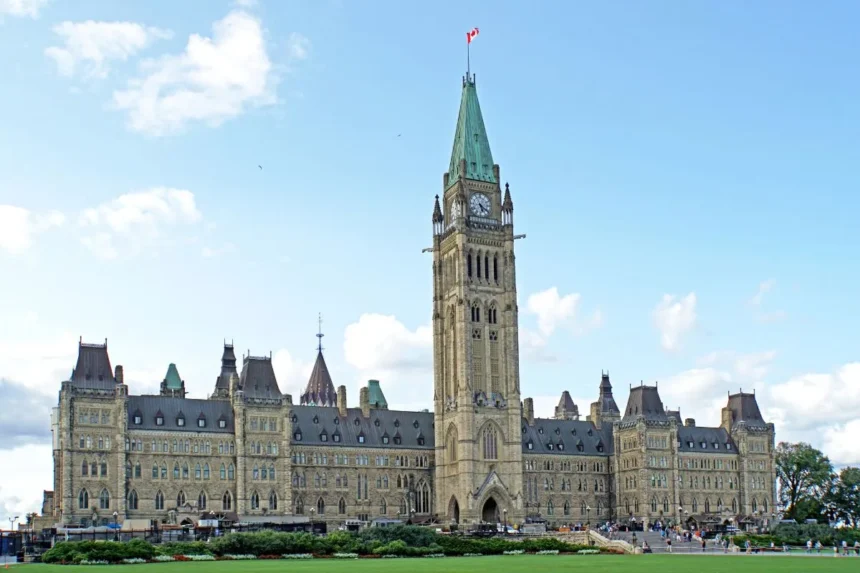Advanced Introduction to Federalism, by Canadian political scientists Alain-G. Gagnon and Arjun Tremblay, is a notable work offering a comprehensive and rigorous exploration of contemporary federalism. This book, structured into ten thematic chapters, not only defines and contextualizes federalism but also examines its relationship with a variety of crucial topics such as democracy, national diversity, and immigration. Additionally, it addresses social and political phenomena less commonly associated with federalism, such as gender, religion, and populism.
- Pillars of Federalism: Concepts and Evolution
- Federalism and Democracy: Synergies and Challenges
- Managing Diversity: Federal Models for Multinational States
- Federalism and Faith: Religious Dynamics in Federal Systems
- Mobility and Governance: Federalism in the Age of Migration
- Equity in Federalism: Gender Perspectives
- Local Power: The Rise of Municipalities in Federal Systems
- Populism and Federalism: Tensions and Transformations
- Crisis and Resilience: The Role of Federalism in the COVID-19 Pandemic
- Colonial Legacy and Federalism: Challenges and Opportunities in Postcolonial States
- Conclusion
Rather than focusing solely on conventional topics, the book examines current issues like the COVID-19 pandemic and the increasing prominence of local power in contemporary democratic societies. It stands out for its comparative approach, presenting case studies from various countries and offering a global and multidimensional perspective on federalism.
This work is an essential contribution for academics, politicians, and anyone interested in unraveling the complexities of federal governance. Its accessibility and analytical depth make it an indispensable read for understanding the challenges and opportunities of federalism in the 21st century.
Pillars of Federalism: Concepts and Evolution
The book begins with an analysis of the fundamental concepts of “federalism” and “federation,” establishing the theoretical framework necessary to better understand the subsequent topics. The authors argue that federalism, derived from the Latin term foedus, has significantly evolved from its original use in ancient Rome, where it denoted a solemn treaty, to its contemporary application in complex political systems. This evolution is not merely historical but reflects the constant need to adapt and redefine the concept to align with global social and political changes.
The analysis offers a nuanced view of the potential advantages and challenges of federalism in democratic contexts.
The distinction between federalism as a philosophical principle and federation as a concrete institutional structure is a key aspect of the discussion. Federalism is portrayed not merely as a system of power division but also as a collection of normative ideas that shape the design and operation of political institutions. This differentiation is vital for understanding the diverse ways federations can be implemented and how federalism can be flexibly adapted to tackle various political and social challenges.
The analysis covers the conceptualization of federalism as a balance between centralization and decentralization. The authors emphasize that this balance is dynamic and that the distribution of power between the central government and subnational governments must be continuously evaluated and adjusted. The discussion includes a review of the different traditions of federalism, particularly the American and Swiss traditions, and how these have influenced the modern practice of federal governance.
Additionally, the notion of “orders of government” is introduced, differentiating between national and subnational levels and examining how these interact in different federal systems. The question of whether municipalities and local communities could be considered a third order of government is raised, a topic explored throughout the book with comparative examples.
Federalism and Democracy: Synergies and Challenges
The book analyses the relationship between federalism and democracy, exploring how these concepts interact and influence each other. It examines whether federalism can both promote and hinder democratic values and institutions, presenting a variety of academic perspectives on this complex issue.
Some scholars argue that federalism is inherently democratic, while others contend that there is no necessary relationship between the two. Through detailed analysis, arguments are presented highlighting how federalism can facilitate democratization by dispersing power and promoting local participation. However, the risks are also noted, such as the possibility of federalism reinforcing ethnic and cultural divisions, which could hinder democratic consolidation.
Democratic backsliding refers to the regression of previously established democratic systems.
The analysis includes case studies illustrating how federalism has impacted democratic evolution. Phenomena such as democratization and democratic backsliding are discussed, and how federal structures can influence these processes is examined.
Democratic backsliding refers to the regression of previously established democratic systems. The book critically examines the role federalism can play in this phenomenon, reviewing the literature on the subject and revealing differing positions on whether federalism can halt or slow authoritarian tendencies or, conversely, exacerbate them.
By integrating these diverse approaches, the analysis offers a nuanced view of the potential advantages and challenges of federalism in democratic contexts. Readers are invited to consider how federal structures can be designed and managed to maximize their democratic benefits while mitigating inherent risks. This deep and comparative exploration provides a starting point for any serious study on the interaction between federalism and democracy.
Managing Diversity: Federal Models for Multinational States
The authors examine federalism in the context of deeply diverse multinational democracies, offering a comprehensive view of how federal systems can manage the coexistence of multiple national groups within a single state. Through a detailed analysis, it presents two models of federalism particularly relevant to these contexts: multinational federalism and intercultural federalism.
The intercultural federalism model addresses both national and immigration-related diversity.
A multinational state is defined as an entity that hosts multiple national groups or demoi within its borders, differing from a nation-state, which comprises a single demos.
This concept is crucial for understanding the tensions and challenges faced by multinational democracies, where power imbalances between the majority nation and minority nations can lead to pressures of assimilation, ethnic conflicts, and secessionist movements.
The multinational federalism model focuses on the institutionalization of constitutional asymmetry, granting special powers to subunits that contain territorially concentrated national minorities. Examples such as Canada and India illustrate how these provisions can recognize and protect the unique cultural and legal identities of minority nations. However, the fragility of these arrangements is also highlighted, as demonstrated by the abrogation of Article 370 in India, which removed the special autonomy of Jammu and Kashmir.
The intercultural federalism model is presented as an alternative that addresses not only national diversity but also diversity resulting from immigration. Unlike multiculturalism, interculturalism emphasizes active integration and continuous dialogue among all communities. It seeks to promote both the cultural continuity of national minorities and the inclusion of immigrants. This model, though promising, still faces significant challenges in its implementation, especially in a global context of growing hostility towards immigrants.
The study of these models reveals both the opportunities and barriers to the effective implementation of federalism in multinational states. The discussion on “federal trust” and “hospitality” (a topic explored by Gagnon in his previous works) provides a theoretical basis for overcoming these challenges, suggesting that trust and mutual respect between different national groups are essential for the success of both multinational and intercultural federalism.
Federalism and Faith: Religious Dynamics in Federal Systems
The book scrutinizes the intersections between federalism and religion, both historically and in contemporary contexts. The discussion ranges from classical contributions that connect federalism with the Judeo-Christian tradition to modern perspectives that challenge and expand this view.
Works of key figures such as Daniel J. Elazar, John Winthrop, and Johannes Althusius are examined, arguing that federalism has deep roots in the ethics and philosophy of the Judeo-Christian tradition. These authors suggest that federalism is not only a governance system but also a moral and ethical framework that promotes cooperation and peaceful coexistence among different religious groups.
This study highlights federalism’s flexibility in managing religious diversity and protecting minority rights.
However, the book also addresses contemporary criticism of this view, noting that federalism can and should be understood beyond its historical connections to Christianity.
In this regard, it explores how federalism has facilitated the establishment of state secularism in countries like Canada, where federal structures have allowed for a clear separation between church and state. This analysis is complemented by case studies illustrating how different federal systems manage religious diversity and promote state neutrality in religious matters.
Another crucial topic is the interaction between federalism and the growing religious diversity in the contemporary world. Examples are analyzed of how federal systems adapt to contexts of religious pluralism, allowing multiple religious traditions to coexist within a common legal framework. This approach highlights the flexibility of federalism in managing religious diversity and protecting minority rights.
Mobility and Governance: Federalism in the Age of Migration
The study of federalism in the context of contemporary migration is essential for understanding how federal systems manage one of the most significant social phenomena of our time. Gagnon and Arjun analyze the key features of “immigration federalism,” highlighting its relevance in the era of globalization and human mobility.
A prominent topic is the identification of the distinctive features of migration federalism, particularly the allocation of immigration-related powers across various government levels. The book explores how conflicts between the federal government and subnational states in countries like the United States have influenced immigration policies and responses to migration issues. It provides examples of states that have enacted progressive integration policies, contrasted with others that have implemented more restrictive measures.
The authors also offer a comparative analysis, examining cases from other federal countries such as Canada, Australia, and Germany. These case studies reveal how different federations have developed unique models to manage migration, adapting to their specific contexts and internal political dynamics. For instance, Canada stands out for its multicultural approach and points-based immigration system, which promotes a more structured and equitable integration of immigrants.
Another crucial aspect of the analysis is the discussion on the tensions between levels of government concerning migration. Conflicts and collaborations between federal, state, and local levels are examined, highlighting how these have influenced the implementation of immigration policies. This approach underscores the importance of intergovernmental cooperation and the need for flexible legal frameworks that allow subunits to tailor their policies to local needs.
The chapter also addresses emerging challenges in migration federalism, such as the integration of refugees and responses to global migration crises. Case studies of countries that have faced large influxes of refugees are presented, showing how their federal systems have responded to these challenges, balancing security needs with humanitarian protection obligations.
By providing a comprehensive and comparative view, this analysis of federalism and migration offers a deep understanding of the complexities and opportunities presented by immigration policies in federal systems. This section of the book is crucial for policymakers, academics, and anyone interested in how federal systems can effectively manage human mobility and promote social cohesion in contexts of diversity and global change.
Equity in Federalism: Gender Perspectives
The book innovatively addresses the intersection between federalism and gender, highlighting the importance of adopting a gender perspective in the study and practice of federalism. It argues that considering gender dynamics is crucial to understanding how federal policies and structures can differentially affect men, women, and people of various gender identities.
Incorporating a gender perspective in federal policy design and implementation is crucial for achieving equitable and inclusive governance.
The necessity of incorporating a gender perspective in the analysis of federal systems is also explored. The book delves into how federalism affects gender equity, highlighting both its positive and negative aspects. For example, decentralization can empower political subunits to create and enforce progressive gender equality policies. On the other hand, it can also lead to regional disparities and the continuation of discriminatory practices in some areas.
The analysis includes a review of comparative studies and specific cases illustrating how different federations have addressed gender issues. Notably, examples from Canada and the United States are highlighted, where gender policies vary significantly between provinces and states.
Another crucial aspect is the discussion on the impact of recent judicial decisions on the intersection of federalism and gender. Cases such as the U.S. Supreme Court’s decision in Dobbs v. Jackson Women’s Health Organization, which has had profound implications for reproductive rights and women’s bodily autonomy in different states, are examined. This analysis shows how federal-level decisions can have disparate effects on political subunits and how federalism can become a battleground for gender rights.
The book thoroughly examines the complexities and challenges of incorporating a gender perspective in the design and implementation of federal policies. This analysis is essential for understanding how federal structures can be adapted to ensure that all individuals, regardless of gender, benefit equitably from public policies and constitutional rights.
Local Power: The Rise of Municipalities in Federal Systems
The analysis of local governments in federal systems highlights the growing importance of cities and municipalities in the structure and functioning of contemporary federalism. As cities become key players in governance, this chapter investigates how federal systems are adapting their structures to incorporate and empower local governments.
The book considers how cities can influence national and global politics and discusses the implications of these dynamics for the future of federalism.
The increasing significance of municipalities and cities in the federalism debate is thoroughly examined. The authors investigate the factors driving this trend, including rapid urbanization, the decentralization of power, and the pressing need for local solutions to global challenges like climate change and migration. They also question whether local governments should be considered a third tier of government, operating in conjunction with national and subnational levels.
The chapter also addresses the issue of the distribution of powers and resources among different levels of government. The dynamics of power and the tensions that arise when local governments seek more autonomy and resources to tackle their challenges are explored. This analysis is fundamental to understanding how federal structures can adapt to balance local autonomy with national coherence.
Another critical aspect is the discussion on citizen participation and local governance. Models of participatory governance that empower citizens at the local level and promote greater transparency and accountability are examined. This approach highlights the importance of local governments as spaces for democratic innovation and civic participation.
Furthermore, the book addresses emerging concerns and theoretical debates about the role of local governments in federal systems. It considers how cities can influence national and global politics and discusses the implications of these dynamics for the future of federalism.
By providing a detailed and comparative analysis of local governments in various federal contexts, this section of the book offers a crucial perspective for policymakers, academics, and anyone interested in the transformative role of local governments in federal systems.
Populism and Federalism: Tensions and Transformations
The study of federalism in the context of the rise of populism offers a critical view of how populist movements and their leaders interact with federal structures, which has significant consequences for political dynamics and governance in various countries.
The book explores the definition and understanding of populism as an electoral strategy and political approach that frequently challenges conventional ideological frameworks and established institutions. It investigates how populist leaders, through their emphasis on mass mobilization and political polarization, can exploit and destabilize federal structures. The analysis includes an in-depth examination of populist leaders in four federal countries: Donald Trump in the United States, Narendra Modi in India, Andrés Manuel López Obrador in Mexico, and Jair Bolsonaro in Brazil.
The case of the United States under Trump’s presidency shows how a populist leader can use federal structures to consolidate power, polarize politics, and challenge established democratic norms. Trump’s strategies for handling relations with the states, tensions over immigration policies, and attempts to undermine the autonomy of state governments not aligned with his agenda are discussed.
In India, Modi’s leadership is analyzed in the context of how his party, the BJP, has used federalism to promote a Hindu nationalist agenda, centralizing power and marginalizing minorities. The tactics used to weaken the autonomy of opposition states and how these actions have affected the country’s federal cohesion are examined.
López Obrador in Mexico represents a different approach, using federalism to implement decentralization policies and combat corruption. However, criticisms of his handling of power and concerns about the potential concentration of authority in the executive are also discussed.
The analysis of Bolsonaro in Brazil highlights how his populist rhetoric and policies have exacerbated federal and social divisions. His confrontations with state governments over the management of the COVID-19 pandemic and other key policies are examined, illustrating the challenges populism poses for federal governance.
The book does not limit itself to federal systems but also explores how populism has impacted unitary states like Italy and the Philippines, providing a broader context for understanding the interaction between populism and federalism.
Crisis and Resilience: The Role of Federalism in the COVID-19 Pandemic
The chapter on federalism and the COVID-19 pandemic offers a comprehensive analysis of how different federal systems responded to one of the most significant global crises of our time. By exploring the pandemic responses in six federal countries—Brazil, Australia, Germany, India, Canada, and the United States—the book provides a comparative view that reveals both the strengths and weaknesses of federalism in times of crisis.
The book offers a critical understanding of how federal systems can adapt and respond effectively to emerging challenges.
One key theme is the variability in the responsiveness of federal systems to the pandemic :
- In Brazil, the fragmented management and lack of coordination between the federal government and the states resulted in a chaotic and uneven response, exacerbating regional disparities and increasing mortality rates. The politicization of the pandemic and the tensions between President Bolsonaro and state governors are clear examples of the challenges federalism faces in health crises.
- Australia, on the other hand, is presented as a relative success, where strong intergovernmental cooperation and the implementation of uniform measures effectively controlled the virus’s spread. The creation of the National Cabinet, which brought together federal and state leaders for decision-making, is highlighted as an exemplary practice of federal coordination.
- Germany also demonstrates an effective response based on its federal structure. The decentralization of powers allowed the Länder (federal states) to tailor their measures to local needs, while the federal government provided guidelines and financial support. This flexibility within a coordinated framework helped maintain a balance between regional autonomy and national coherence.
- In India, the pandemic response reveals a series of challenges, including coordination problems between the central government and states and difficulties in implementing uniform policies in a highly diverse country. India’s pandemic management highlights the complexities of federalism in contexts of significant socio-economic and cultural heterogeneity.
- The analysis of Canada underscores the importance of intergovernmental collaboration in its pandemic response. Despite initial tensions between federal and provincial levels, the establishment of coordination mechanisms and the provision of adequate resources allowed for a more coherent and effective response. Variations in provincial policies, however, reflect regional differences and the challenges of maintaining a unified strategy in a federal system.
- In the United States, the handling of the pandemic was marked by notable fragmentation and disparity in state responses. The lack of a cohesive national strategy and the politicization of the crisis resulted in inconsistent responses, with some regions implementing strict measures while others adopted more lax approaches. This case illustrates how federal dynamics can complicate crisis management when coordination and central leadership are lacking.
Thus, the analysis offers a critical understanding of how federal systems can adapt and respond effectively to emerging challenges, emphasizing the importance of coordination, flexibility, and intergovernmental cooperation.
Colonial Legacy and Federalism: Challenges and Opportunities in Postcolonial States
The final chapter of the book examines federalism in the context of postcolonial and colonized states, providing a deep insight into how the colonial legacy influences the structures and dynamics of federal systems in these countries. This exploration is crucial for understanding the particularities and challenges faced by states seeking to implement or maintain federal structures in societies marked by diversity and colonial heritage.
The potential existence of a Eurocentric bias in the study of federalism is highlighted by the authors. They argue that many theories and models of federalism have been developed in Western contexts and may not be fully applicable or effective in postcolonial states. There is a need to adapt and reformulate these concepts to be relevant in contexts with different historical and socio-political realities.
The analysis focuses on how federalism can contribute to decolonization and reconciliation processes in states with significant indigenous populations and other historically marginalized minorities. Cases from countries like Canada and Australia are presented, where federalism has been used as a tool to negotiate and restructure relationships between the state and indigenous communities. For example, in Canada, negotiations over indigenous governance and self-government agreements are crucial aspects of a federalism that seeks to recognize and respect the rights of indigenous peoples.
Additionally, the dynamics of federalism in postcolonial states such as India and Nigeria are explored, where ethnic, linguistic, and religious diversity poses unique challenges for national cohesion. In India, federalism has allowed some flexibility to accommodate the demands of various ethnic and linguistic groups, but has also faced tensions and conflicts related to power centralization and identity politics. In Nigeria, federalism has been a mechanism to manage diversity and regional tensions, albeit with significant difficulties.
The chapter also addresses experiences of federalism in other postcolonial states like Ethiopia and South Africa, which have used federal structures to balance regional autonomy demands with the need for a strong central government. In Ethiopia, ethnic federalism has been a strategy to manage the country’s ethnic diversity, though it has sparked debates about its effectiveness and sustainability. In South Africa, federalism has been part of the post-apartheid transition, attempting to balance power dynamics among various provinces and communities.
The exploration of these cases reveals both the opportunities and challenges inherent in using federalism in postcolonial contexts. The ways in which federalism can help foster social justice and inclusion are discussed, alongside the difficulties of implementing federal systems in societies with deep historical divisions and persistent inequalities.
The chapter concludes by reflecting on the future of federalism in postcolonial and colonized states. Questions are raised about how these states can continue to adapt and evolve their federal systems to effectively address the demands of their diverse populations and promote equitable and sustainable governance. This final section of the book offers a critical and hopeful perspective on the role of federalism in creating more just and inclusive states in the 21st century.
Conclusion
“Advanced Introduction to Federalism” stands as an indispensable reference for any scholar or professional interested in the field of federalism. Through its ten thematic chapters, the book provides a comprehensive and multifaceted analysis of federalism’s various dimensions, from its theoretical foundations to its application in complex contemporary contexts.
This work is notable for its academic rigor and its ability to address both relevant and emerging topics in the study of federalism. The combination of deep theoretical analysis and practical case studies offers an integral view that facilitates an understanding of not only the fundamental principles of federalism but also how these principles are applied and adapted in different national and global contexts. The attention to the variability and flexibility of federalism is particularly valuable, showing how this system of governance can respond to contemporary challenges such as migration, ethnic and religious diversity, gender equality, and global crises like the COVID-19 pandemic.
Each chapter provides a unique and detailed perspective, exploring how federalism interacts with other aspects of society and politics. From its intersection with democracy and populist movements to the management of national diversity and the response to global crises, the book offers a critical and up-to-date analysis that enriches our understanding of federalism.
The conceptual clarity, comparative approach, and analytical depth make Advanced Introduction to Federalism an essential read for scholars, students, policymakers, and anyone interested in understanding how federal structures can contribute to more just, inclusive, and effective governance.
Gagnon and Arjun’s book not only illuminates the past and present of federalism but also provides valuable insights for its future. It is an outstanding contribution that will surely guide the study of federalism in addressing the challenges of governance in an increasingly complex and diverse world.









